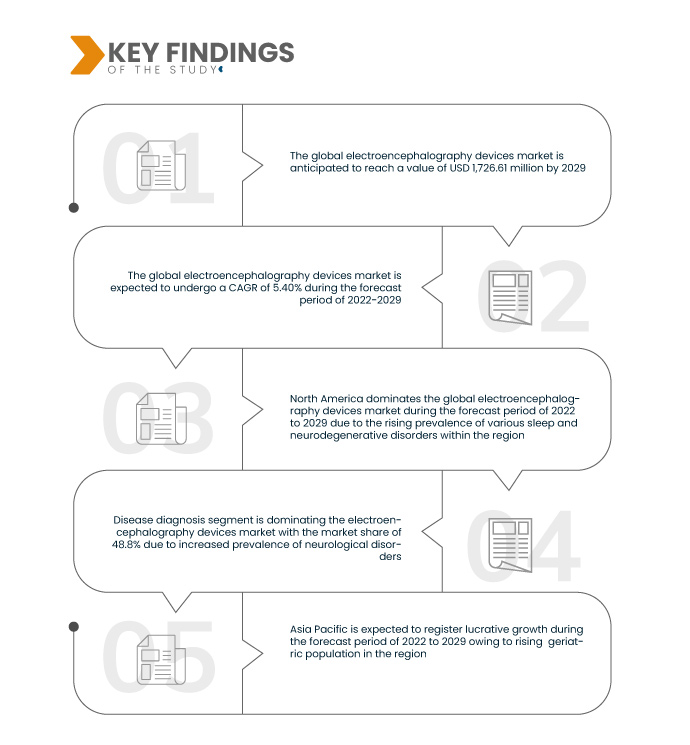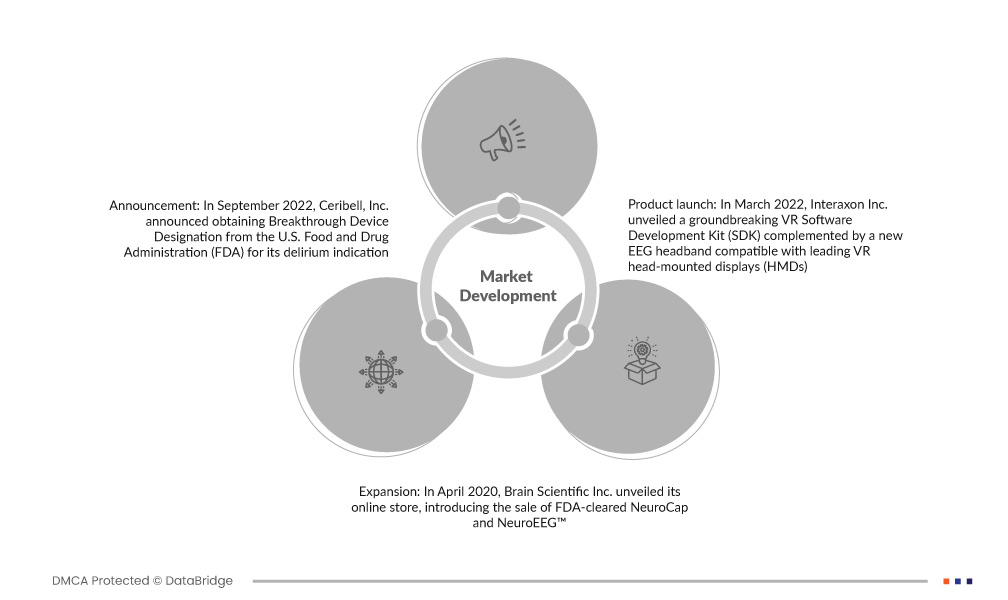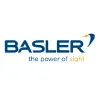The global electroencephalography devices market encompasses a diverse range of technologies designed for monitoring and recording brain activity. These devices play a crucial role in neuroscience, clinical diagnostics, and research, providing valuable insights into brain function and disorders. EEG devices are utilized in various settings, including hospitals, research institutions, and outpatient facilities, contributing to the understanding of conditions such as epilepsy, sleep disorders, and neurodegenerative diseases. As healthcare systems worldwide continue to prioritize neurological care, the EEG devices market is expected to witness sustained growth.
Access Full Report @ https://www.databridgemarketresearch.com/reports/global-electroencephalography-devices-market
Data Bridge Market Research analyses that the Global Electroencephalography Devices Market was valued at USD 1,110.68 million in 2021 and is expected to reach USD 1,726.61 million by 2029, registering a CAGR of 5.40% during the forecast period of 2022-2029. The growing trend of telemedicine and remote patient monitoring has spurred the demand for portable and user-friendly EEG devices. These devices enable healthcare professionals to monitor and diagnose patients' brain activity remotely, improving accessibility to neurological care.
Key Findings of the Study
Increasing healthcare expenditure is expected to drive the market's growth rate
The escalating global healthcare expenditure, notably in neurological care, propels the uptake of advanced medical technologies such as EEG devices. This financial commitment empowers hospitals and healthcare facilities to procure cutting-edge equipment, enhancing diagnostic and monitoring capabilities in neurological disorders. The increased funding reflects a commitment to leveraging innovative solutions, ensuring better patient outcomes and fostering advancements in neurology.
Report Scope and Market Segmentation
|
Report Metric
|
Details
|
|
Forecast Period
|
2022 to 2029
|
|
Base Year
|
2021
|
|
Historic Years
|
2020 (Customizable to 2014-2019)
|
|
Quantitative Units
|
Revenue in USD Million, Volumes in Units, Pricing in USD
|
|
Segments Covered
|
Product Type (Devices, Accessories, Consumables), Type (Portable, Standalone, Wearable), Usability (Disposable, Semidisposable, Reusable), Procedure (Routine EEG, Sleep-Deprived EEG, Ambulatory EEG, Others), Function (Standard EEG, Ambulatory EEG, Video EEG), Signal Frequency (Delta (3 Hz or Below), Theta (3.5 to 7.5 Hz), Alpha (7.5 and 13 Hz), Beta (14 and Greater Hz)), Filtering Settings (Low Frequency Filter (1 Hz), High Frequency Filter (50-70 Hz), Notch Filter, Bandpass Filter), Age Group (Pediatric, Adult, Geriatric), Application (Disease Diagnosis, Sleep Monitoring, Anesthesia Monitoring, Trauma and Surgery, Others), End User (Hospitals, Neurology Centers, Ambulatory Surgical Centers, Diagnostic Centers, Academic and Research Organizations, Others), Distribution Channel (Direct Tender, Retail Sales)
|
|
Countries Covered
|
U.S., Canada and Mexico in North America, Germany, France, U.K., Netherlands, Switzerland, Belgium, Russia, Italy, Spain, Turkey, Rest of Europe in Europe, China, Japan, India, South Korea, Singapore, Malaysia, Australia, Thailand, Indonesia, Philippines, Rest of Asia-Pacific (APAC) in the Asia-Pacific (APAC), Saudi Arabia, U.A.E, South Africa, Egypt, Israel, Rest of Middle East and Africa (MEA) as a part of Middle East and Africa (MEA), Brazil, Argentina and Rest of South America as part of South America
|
|
Market Players Covered
|
Cadwell Industries Inc. (U.S.), Compumedics Limited (Australia), NeuroWave Systems Inc. (U.S.), Natus Medical Incorporated (U.S.), Medtronic (Ireland), NIHON KOHDEN CORPORATION (Japan), NeuroSky (China), Bio-Signal Group Corp. (U.S.), Elekta AB (Sweden), Lifelines Neuro (U.S.), Neurosoft S.A. (Greece), EMS Handels Gesellschaft mbH (Austria), Jordan NeuroScience, Inc. (U.S.), BrainScope Company Inc. (U.S.), Advanced Brain Monitoring, Inc. (U.S.), EB Neuro S.p.A. (Italy), g.tec medical engineering GmbH Austria (Austria), Bitbrain Technologies (Spain), Electrical Geodesics, Inc. (U.S.), Masimo (U.S.), ELMIKO MEDICAL sp. Z oo (Poland), and Micromed (Italy), among others
|
|
Data Points Covered in the Report
|
In addition to the insights on market scenarios such as market value, growth rate, segmentation, geographical coverage, and major players, the market reports curated by the Data Bridge Market Research also include depth expert analysis, patient epidemiology, pipeline analysis, pricing analysis, and regulatory framework.
|
Segment Analysis:
The global electroencephalography devices market is segmented on the basis of product type, type, usability, procedure, function, signal frequency, filtering settings, age group, application, end user and distribution channel.
- On the basis of product type, global electroencephalography devices market is segmented into devices, accessories and consumables. Devices segment holds the highest share in the electroencephalography devices market with the market share of 50.9% due to rising adoption of electroencephalography (EEG) devices
- On the basis of type, global electroencephalography devices market is segmented into portable, standalone, and wearable. Standalone segment is dominating the electroencephalography devices market with the market share of 58.1% due to growing demand for highly advanced and efficient electroencephalography devices for treatment
- On the basis of usability, global electroencephalography devices market is segmented into disposable, semi disposable, and reusable. The reusable segment is dominating the electroencephalography devices market with a market share of 62.83% due to the rising incidence of neurological disorder in low and middle-income countries
- On the basis of procedure, global electroencephalography devices market is segmented into routine EEG, sleep-deprived EEG, ambulatory EEG, and others. The routine EEG segment is dominating the electroencephalography devices market with a market share of 52.5% due to increasing number of wealthy hospitals across the world
- On the basis of function, global electroencephalography devices market is segmented into standard EEG, ambulatory EEG, and video EEG. Standard EEG segment is dominating the electroencephalography devices market with the market share of 66.3% due to escalation in technology advancement
- On the basis of signal frequency, global electroencephalography devices market is segmented into delta (3 HZ or below), theta (3.5 to 7.5 HZ), alpha (7.5 and 13 HZ), and beta (14 and greater HZ). Delta (3 Hz or below) segment is dominating the electroencephalography devices market with the market share of 44.1% as it provides information regarding the conditions such as encephalopathy hydrocephalus among others
- On the basis of filtering settings, global electroencephalography devices market is segmented into low frequency filter (1 Hz), high frequency filter (50-70 Hz), notch filter, and bandpass filter. Low frequency filter (1 Hz) segment is dominating the electroencephalography devices market with the market share of 56.2% due to escalation in technological advancement
- On the basis of age group, global electroencephalography devices market is segmented into pediatric, adult, and geriatric. Adult segment is dominating the electroencephalography devices market with the market share of 65.7% due to growing awareness about neurological disorders among adult population
- On the basis of application, global electroencephalography devices market is segmented into disease diagnosis, sleep monitoring, anesthesia monitoring, trauma and surgery, and others. Disease diagnosis segment is dominating the electroencephalography devices market with the market share of 48.8% due to increased prevalence of neurological disorders such as epilepsy, Alzheimer’s disease and others across the globe
Disease diagnosis segment is dominating the electroencephalography devices market
Disease diagnosis segment is dominating the electroencephalography devices market with the market share of 48.8% due to increased prevalence of neurological disorders such as epilepsy, Alzheimer’s disease and others across the globe. Their diagnostic precision and non-invasive nature position them as essential tools for effective disease diagnosis in the field of neurology.
- On the basis of end user, global electroencephalography devices market is segmented into hospitals, neurology centers, ambulatory surgical centers, diagnostic centers, academic and research organizations, and others. Hospitals segment is dominating the electroencephalography devices market with the market share of 54.0% due to growing number of hospitals in low and middle income countries
- On the basis of distribution channel, global electroencephalography devices market is segmented into direct tender, and retail sales. Direct tender segment is dominating the electroencephalography devices market with the market share of 73.9% due to having full control over the sales and revenue process as well as direct interaction with your customers
Direct tender segment is dominating the electroencephalography devices market with the market
Direct tender segment is dominating the electroencephalography devices market with the market share of 73.9% due to having full control over the sales and revenue process as well as direct interaction with your customers. This method ensures a streamlined purchasing process, competitive pricing, and the ability to negotiate terms, making it a preferred choice for acquiring electroencephalography devices in the healthcare sector.
Major Players
Data Bridge Market Research recognizes the following companies as the major global electroencephalography devices market players in global electroencephalography devices market are Cadwell Industries Inc. (U.S.), Compumedics Limited (Australia), NeuroWave Systems Inc. (U.S.), Natus Medical Incorporated (U.S.), Medtronic (Ireland), NIHON KOHDEN CORPORATION (Japan), NeuroSky (China)
Market Developments
- In September 2022, Ceribell, Inc. announced obtaining Breakthrough Device Designation from the U.S. Food and Drug Administration (FDA) for its delirium indication. The system integrates machine learning to analyze electroencephalography (EEG) signals for the detection of delirium. This recognition by the FDA underscores the innovative approach of Ceribell's technology in utilizing advanced analytics to enhance the identification and management of delirium, marking a significant milestone in the application of machine learning in healthcare
- In March 2022, Interaxon Inc. unveiled a groundbreaking VR Software Development Kit (SDK) complemented by a new EEG headband compatible with leading VR head-mounted displays (HMDs). This release builds upon Interaxon's second-generation EEG meditation and sleep headband, expanding its applications into the virtual reality realm. The integration of the SDK and EEG headband marks a significant stride in merging neurotechnology with virtual experiences, offering users a unique and immersive interface that combines meditation and sleep insights with virtual reality environments
- In April 2020, Brain Scientific Inc. unveiled its online store, introducing the sale of FDA-cleared NeuroCap and NeuroEEG™. The NeuroCap is an innovative disposable headset designed for single-use, eliminating cross-contamination risks associated with traditional reusable EEG electrodes. This launch signifies a strategic move towards enhancing accessibility and hygiene in neurological monitoring, offering a cost-effective and efficient solution for healthcare practitioners and facilities embracing advanced EEG technology
Regional Analysis
Geographically, the countries covered in the global electroencephalography devices market report are U.S., Canada and Mexico in North America, Germany, France, U.K., Netherlands, Switzerland, Belgium, Russia, Italy, Spain, Turkey, Rest of Europe in Europe, China, Japan, India, South Korea, Singapore, Malaysia, Australia, Thailand, Indonesia, Philippines, Rest of Asia-Pacific (APAC) in the Asia-Pacific (APAC), Saudi Arabia, U.A.E, South Africa, Egypt, Israel, Rest of Middle East and Africa (MEA) as a part of Middle East and Africa (MEA), Brazil, Argentina and Rest of South America as part of South America
As per Data Bridge Market Research analysis:
North America is the dominant region in the global electroencephalography devices market during the forecast period 2022-2029
North America dominates the global electroencephalography devices market due to a surge in the prevalence of sleep and neurodegenerative disorders in the region. The robust healthcare infrastructure, coupled with heightened awareness and early diagnosis initiatives, positions North America at the forefront of EEG device adoption. This dominance reflects the region's commitment to addressing neurological health challenges and underscores the pivotal role of EEG technology in diagnosing and managing sleep-related and neurodegenerative conditions.
Asia-Pacific is estimated to be the fastest-growing region in the global electroencephalography devices market during the forecast period 2022-2029
Asia-Pacific is expected to dominate the global electroencephalography devices market from 2022 to 2029, driven by a substantial increase in the region's geriatric population. The rising elderly demographic in Asia-Pacific fuels the demand for advanced neurological monitoring tools. This trend reflects an increasing focus on healthcare for aging populations, positioning the region as a key contributor to the growth of the electroencephalography devices market during the forecast period.
For more detailed information about the global electroencephalography devices market report, click here – https://www.databridgemarketresearch.com/reports/global-electroencephalography-devices-market












